

Table of contents
- Location
- substrate
- Plant
- plant cutting
- tub culture
- Pour
- Fertilize
- Repotting of potted plants
- Cut
- multiply
- sticks
- hibernate
- diseases and pests
The dwarf blood plum is ideal for small gardens and front gardens because it grows very slowly as a shrub up to two meters high. In order for her to flaunt her pretty blooms in spring and grow healthily, she needs a few important ones Location factors and care measures so that it grows healthy and strong for many years and an impressive one every year Produce abundance of flowers.
Location
The dwarf blood plum, botanically called Prunus cistena, prefers sunny to partially shaded locations. If it gets too little light, this affects the beautiful red coloring of the leaves. The ornamental shrub is very robust. It tolerates both heat and cold and adapts well to a wide variety of conditions in the garden.
- Light requirements: sunny to semi-shady
- also tolerates full sun
- warm and protected
substrate
Prunus cistena is generally considered not very demanding and therefore grows on almost any garden soil that is not too dry. However, the dwarf blood plum finds optimum conditions for healthy growth in fresh, nutrient-rich soil.
- fresh
- humorous
- permeable to water
- nutritious
- not too dry
Plant
The dark red foliage and spectacular pink-white flowers in spring make the dwarf blood plum a perfect candidate for a single planting in a prominent spot in the border. But also as a group or hedge, it is an absolute eye-catcher in the home garden. In principle, container plants can be planted at any time, as long as the ground is not frozen. However, the best time for planting ornamental trees is spring and autumn.
- Planting distance: about 1 m
- one to two plants per square meter for hedges
- Planting hole: double root ball width and depth
- Enrich the excavation with mature compost or humic potting soil
- Loosen the bottom of the hole with the digging fork
- water well before planting
- Fill half of the planting hole with soil
- Remove the pot and insert the wood in the middle
- Fill up the substrate and start lightly
- do not plant deeper than before
- possibly hammer in a support post for tall trunks
plant cutting
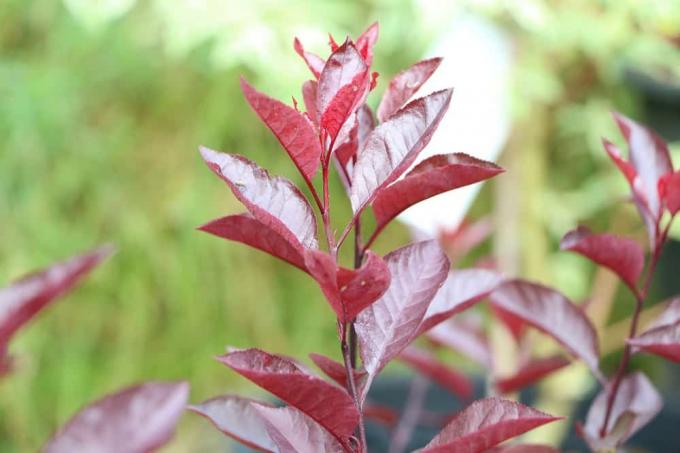
Every time you change location, for example when planting after purchase, you should cut back vigorously. In this way you keep the volume of shoots and root ball in balance.
- reduce about a third of the branches
- Time: when planting
- Root ball and tree crown should have the same volume
tub culture
Standard stems of the dwarf blood plum are particularly popular as potted plants for terraces, balconies and entrance areas. Hardly any other tree has such a high ornamental value as Prunus cistena. In the first few years, a pot size of about 30 liters is sufficient. Then either repotted or the root ball rejuvenated. Regular water and fertilizer are particularly important when growing in pots.
Pour
As a young shrub or standard tree, the cherry plum needs regular watering. The substrate should be allowed to dry slightly, but never dry out completely. Later, watering is only necessary if the drought lasts longer. When keeping them in buckets, however, the gardener should always ensure a good water supply. If potted plants are completely dried out, it is best to place them in a large tub of water so that the root ball can soak up water again.
Fertilize
With a nutrient-rich garden soil, no additional fertilizer is necessary. However, it does not hurt to work in mature compost around the root area in spring. In the case of nutrient-poor soils or potted plants, it has proven useful to use horn shavings or other long-term fertilizers. These release the nutrients only slowly, so that the dwarf blood plum is supplied over a longer period of time.
Repotting of potted plants
If the roots already take up the entire pot, a larger container is necessary. Alternatively, about 2 cm of the root felt can be cut out at the edge and bottom of the ball. This creates space in the planter for the next time.
Cut
As a dwarf variety of blood plum, the attractive wood only reaches a height of around 1.5 meters. The annual growth is not particularly lush. The dwarf blood plum only gains about ten centimeters each year. However, in order to maintain the flowering growth, a regular cut is advisable. This creates space for new shoots. A pruning or shaping is possible at different times. Because if the shrub is never cut, it will flower less and less over time.
After flowering
A slight pruning after flowering is the ideal time to achieve a rich bloom in the following year. The dwarf blood plum forms the flower buds on the previous year's wood. That is why flowering does not occur if pruning is carried out too late in the year or in early spring.
In the autumn
The small, plum-like fruits of the cherry plum are edible and are also commonly harvested by gardeners. Since pruning after flowering results in a reduced harvest in autumn, these garden owners prefer to cut their shrubs or standard trees in autumn. In this case, flowering will be less abundant in the following spring.
care cut
Prunus cistena can be trimmed into old age. This cut is not used for shaping, but only to maintain the health of the wood. In general, a care cut can take place all year round, but it is best done in the spring after the budding.
- cut all frozen or dead shoots down to the healthy wood
- Cut out all diseased shoots
- Cut branches that grow inwards to the base
- take out one of two crossing shoots
- Completely cut off water shoots (long shoots with few leaves).
- do not leave any branch stumps
To stimulate branching, faded shoots can be shortened by about five buds. However, this should not happen too often, otherwise the typical, upright growth habit of the shrub will be lost and the dwarf blood plum will be bare from the inside.
Cut high trunk
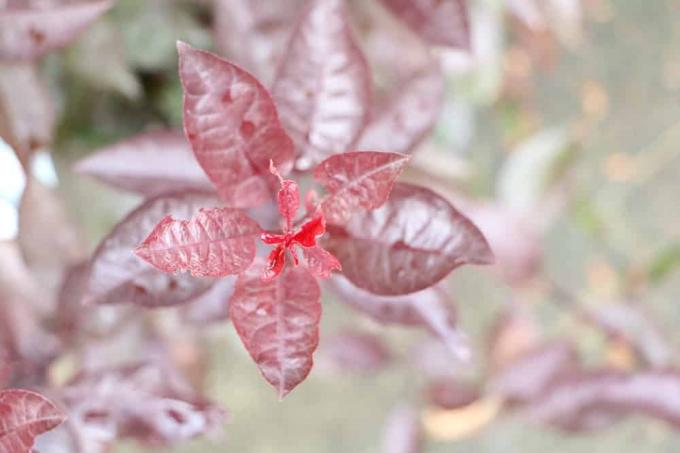
Standard stems of the dwarf blood plum are usually grafted onto a wild plum rootstock. If new shoots grow from the trunk or the root area, they must be removed promptly at the base. If the rootstock begins to grow, it can happen that the tree sheds the grafted crown. Otherwise, the shoots are subjected to a maintenance cut every year. If the crown becomes too large or dense, it is either shortened or thinned out so that light can come in again.
- always leave at least one bud (eye) above the grafting point
- too long, unbranched shoots after the 3rd until 5. cut eye
- generally prefer to cut less
- remove one of two shoots that are too close together
Normally, to maintain the shape of tall stems, it is completely sufficient to young shoots, whose leaves are slightly lighter than those of the previous year, after flowering cut back.
multiply
There are several ways to propagate the dwarf blood plum. The shrubs form relatively long, flexible shoots from which sinkers can easily be pulled. In addition, the flowering shrub can be pulled over woody cuttings.
lowering
For sinkers, you choose a flexible, long shoot and guide it into the ground. Where the shoot comes into the ground, remove the leaves and cover it with soil. For a better hold, you can weigh down the shoot with a stone. It is important that the shoot looks out of the ground at the other end. When the sinker has rooted after a few weeks, it can be cut off and replanted elsewhere.
sticks
In contrast to many other flowering shrubs, it is somewhat difficult to pull cuttings from the fresh shoot tips of the dwarf blood plum. Head cuttings from this year's shoots die off easily, while cuttings from last year's woody shoots are more robust and take root relatively easily. Basically, propagation by cuttings is a special type of propagation by cuttings. The big difference is that the cutting is cut during the dormant phase in winter and is therefore leafless.
cutting sticks
- Time: frost-free day in late autumn to winter
- Starting material: shoots from the previous year
- Length: at least 20-30 cm
- cut at the level of a two-year-old branch ring
- Interface: just below the astring
- always use clean, sharp tools
- Divide shoots into pencil-length pieces
- Sticking wood must end with an eye at the top and bottom
If you are not sure that you are correctly identifying the direction of growth based on the buds, you can cut off the lower end of the stick at an angle. Because it is important that the sticks are later inserted into the soil in the correct direction of growth, otherwise they will not grow.
put stick
Since the cuttings of dwarf blood plums are slow to root, it is advisable to seal the top with wax or a wound sealant. This prevents drying out and increases the chances of growth.
- Put shoots immediately in a partially shaded bed
- loosen the soil well beforehand
- possibly enrich with humus-rich potting soil
- Alternatively, choose a large plant pot and fill it with humus-rich soil
- Insert sticks deeply
- only the upper bud may stick out
- insert several drive pieces at the same time
- pour on
It is possible to put several sticks in a plant pot. After watering, you can leave the sticks to themselves until spring. If the ground freezes through, that's no problem, because Prunus cistena is sufficiently hardy. From the end of March, the rooted sticks are then transplanted to their actual location. It is advisable to cut back the new shoots to three to four leaves from the end of May to encourage branching.
hibernate
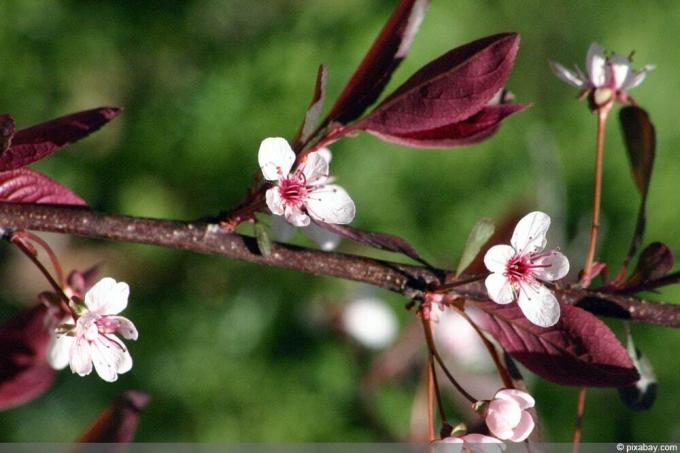
The robust shrub tolerates both heat and cold well. Even frosty temperatures do not cause any problems for the dwarf blood plum. It is considered frost-resistant up to -30 degrees. Nevertheless, winter protection is recommended for planted specimens in the first winter after planting. Since the roots of new plantings do not yet reach that deep into the earth and thus reach into regions that do not freeze through, the roots are still somewhat sensitive. The shoots are less vulnerable to frost than the roots and therefore do not require special protection.
- Provide young plants in the bed with winter protection in the first year
- Cover the soil thickly with leaves, straw or mulch
- Potted plants always need winter protection
- Place bucket in a sheltered place
- underlay thick styrofoam plate
- Wrap air foil or several layers of fleece around the pot
- Cover substrate surface with straw or leaves
- Water in dry, warm weather
diseases and pests
The right location and suitable soil quality ensure healthy, resilient dwarf blood plums. Occasionally, Prunus cistena is infested by aphids. However, these can usually be removed with simple household remedies. However, if the weather is humid for a longer period of time, this can lead to diseases.
shotgun disease
This disease is a fungal infection. It can be recognized by small brown spots on the leaves that eventually shed, leaving holes. Affected leaves should be removed and disposed of with household waste. As a countermeasure, fungicides or special copper preparations can be used. These are also necessary again in the following year before the leaves sprout.
Monilia peak drought
Another fungal infection is the Monilia spike drought. The disease can be recognized by the withered shoot tips of the dwarf blood plum. Combating it is difficult because the spores of the fungus spread rapidly. It is best to remove affected parts of the plant generously and cut back into healthy wood. Since the disease is very contagious, the cut shoots must be disposed of immediately with household waste or burned. Don't forget to clean the tools thoroughly as well to avoid infecting other plants. There are plant protection products against the Monilia peak drought on the market. However, their effect on severely diseased plants is very limited.
 garden editorial
garden editorial I write about everything that interests me in my garden.
Learn more about fruit trees
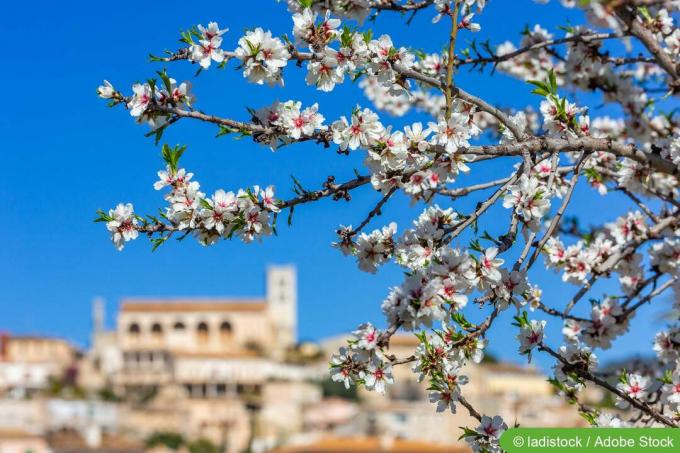
Life on Mallorca: highlight almond blossom
Life on Mallorca offers a lot more than sun, summer, beach and Ballermann. The beginning of the year on the popular holiday island is all about blossoming almond trees. We'll tell you when and where you can best enjoy the almond blossom on Mallorca.

Cutting sour cherries: 21 tips for the right cut
In order for a sour cherry to remain productive year after year, it must be pruned regularly. Wood that has been removed must be removed and new fruit wood must be promoted. This only works if the "editor" knows the editing rules.

Is the ornamental peach edible? | 15 tips for care and cutting
The ornamental peach can be a decorative addition to the garden as early as March, when the trees, which are up to three meters high, are in bloom. Here we tell you how to look after them and whether their fruits are edible.

20 old apple varieties | List of old apples in & around Germany
Hardly any type of fruit is as diverse as the apple. The number of apple varieties worldwide is estimated at over 20,000. Old apple varieties are those that were discovered before 1950. We have compiled a list of popular, old varieties for you.
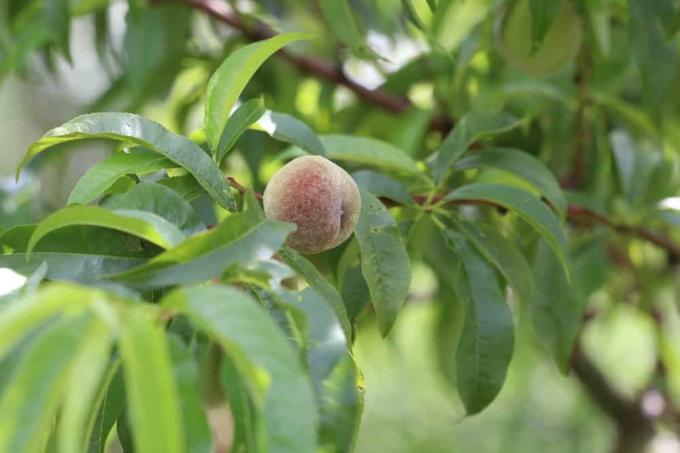
Peach Tree Diseases: Leaves curl or turn yellow
Among the fruit trees, the peach tree is one of the most susceptible to diseases. It often has to contend with fungal diseases such as curling disease. Here you can find out which other tree diseases can affect it, how to recognize them and how to fight them successfully.

Half-trunk cherry and apple trees: planting distance and care
Fruit trees definitely belong in every garden. But what to do if the garden is too small for a large tree? Then trees that were grown as half-stems can help. They take up less space, but deliver lots of fruit. More about this here.



